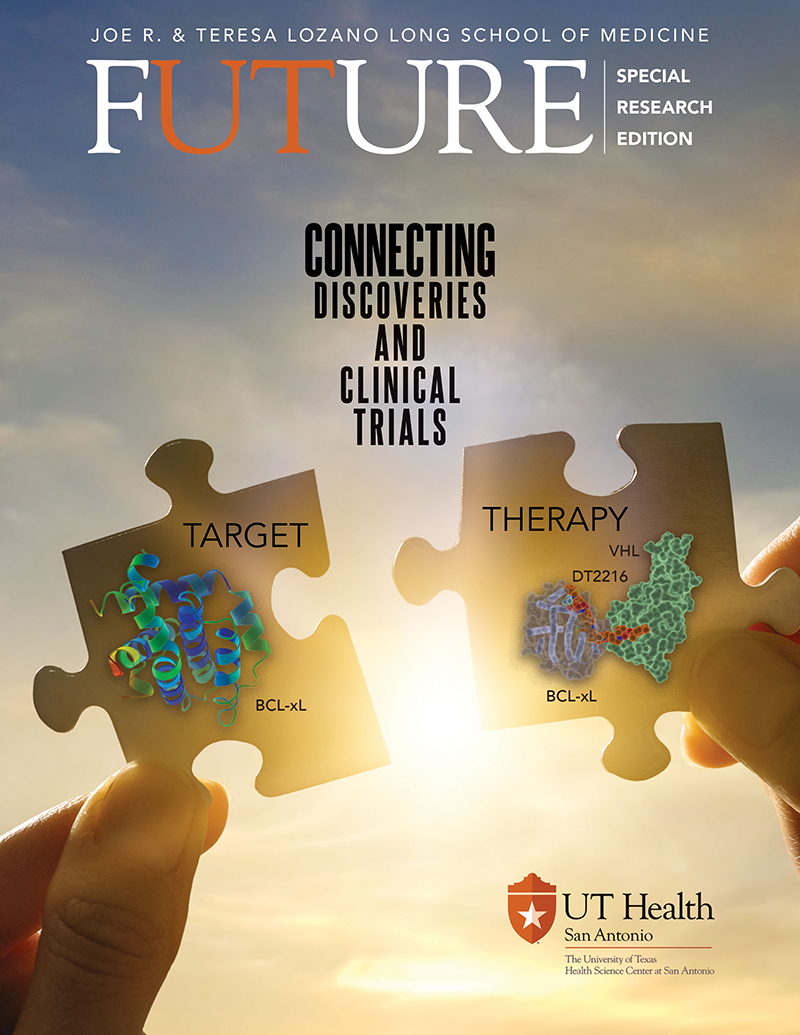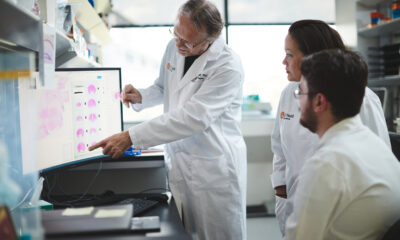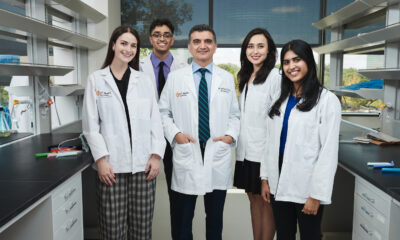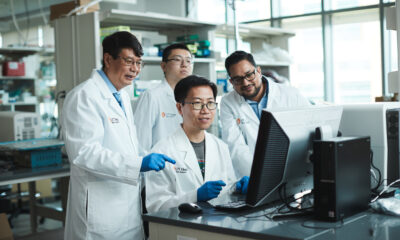Unicorns among the mesquite

The spectacular growth of San Antonio’s bioscience industry
By Michael Seringer
The rapid innovation of the early oil industry convinced Tom Slick Jr. that the progress of humankind was dependent on scientific discovery. In 1941, he built the Texas Biomedical Research Institute on the west side of San Antonio. Six years later, he added the Southwest Research Institute on his 1,200-acre ranch.
Slick, an adventurer and oilman, was the son of Tom Slick Sr., known as “The King of the Wildcatters” for his discovery of the prolific Cushing oil field in Oklahoma. Like any oilman who was used to risking it all, Slick Jr. put his money on the promise of biomedical science, which at that time was a novel concept. His research ventures put San Antonio on the trajectory to become a leading biomedical destination.
The pharmaceutical, medical device and diagnostic discoveries long ago envisioned by Slick are coming to fruition today in San Antonio. Nonprofits, academic institutions and private enterprises are working together to create a golden age of discovery, living out Slick’s spirit of innovation and making San Antonio a remarkable place for biotechnology breakthroughs.
Eighteen years after Slick founded Texas Biomed, The University of Texas Health Science Center at San Antonio would rise from a cattle pasture just a few miles northwest of downtown San Antonio. This new medical school drew heavily on the long history of excellence in San Antonio’s system of military health care to rapidly become a leading health and research center.
In 1969, 10 years after the founding of UT Health Science Center at San Antonio, The University of Texas at San Antonio was launched on the city’s far northwest side, adding another public research institution to the community of discovery. Today, the trifecta of nonprofit research institutes, such as Southwest Research Institute and Texas Biomed, academic research institutions, such as UT Health San Antonio and UTSA, and an active private equity community is positioning San Antonio as a leading center for bioscience.
A collaborative community
“San Antonio has a vibrant biomedical research community, including UT Health San Antonio, UTSA, Southwest Research Institute and Texas Biomedical Research Institute,” said Daohong Zhou, MD, UT Health San Antonio professor of biochemistry and structural biology, director of the Center for Innovative Drug Discovery, and associate director of drug discovery for the Mays Cancer Center.
“Together, we can more rapidly translate basic research into the clinic by conducting advanced drug development research,” Zhou said.
The spirit of collaboration among San Antonio’s biotechnology and medical device community has its origins in the history of cooperation between the military, academic and nonprofit research institutions.
San Antonio’s reputation as a collegial, unpretentious place extends to the growing life science community. The spirit of collaboration among San Antonio’s biotechnology and medical device community has its origins in the history of cooperation between the military, academic and nonprofit research institutions.
Heather Hanson is president of BioMedSA, an industry hub promoting the growth of the health care and bioscience sectors in San Antonio. She believes collaboration is a core value of the life science community in San Antonio.
“Collaboration is woven into the fabric of San Antonio’s bioscience and medical technology industry,” Hanson said. “There are existing relationships and contracts that make partnering among academic institutions, businesses and nonprofits very efficient. It really speeds up the process of innovation.”
Robert Hutchens, CEO of StemBioSys — a San Antonio-based biotechnology company formed from technology licensed from UT Health San Antonio — quickly realized the culture of collaboration that existed in San Antonio after he relocated to become CEO.
“There is an extraordinary infrastructure here with Southwest Research Institute and academic institutions that gives us local partners to work with, whether it’s new customers, new product development or new applications of our product. It’s a pretty remarkable environment,” Hutchens said.
Collaboration among institutions that have very distinct capabilities helps set San Antonio apart from many other research centers. “Southwest Research Institute has some very unique assays that other contract research organizations simply don’t have,” said John Gebhard, PhD, assistant vice president of technology commercialization and executive director of innovation and industry ventures at UT Health San Antonio.
“They have some intellectual property and capabilities for rational drug design that others don’t. It gives San Antonio-based research an advantage.”
By continuing to invest in leading technologies, institutions attract greater research talent to the local community. New capital investments in research capability drive more scientific interest in San Antonio. It’s the spirit of collaboration among bioscience stakeholders, however, that keeps highly specialized talent from leaving.
Committed investors
While most venture capital firms never travel south past Austin, San Antonio has been able to put together many life science deals based on an active network of individual local investors. Investigators who tap into friends and family and angel financing networks generally benefit from a longer-term investment horizon, resulting in less pressure than with traditional venture capital.
Larger private equity funds and venture capital firms are looking to minimize risk while maximizing their payoff. This means exiting the investment as soon as possible — a difficult goal in the biotechnology industry. Alternative financing strategies allow company founders to focus on the quality of the molecule or medical device without the push to cash out.
“The way we have financed StemBioSys has been through a lot of smaller investors here in the community,” Hutchens said.
“What has been remarkable to me is the support we have from the community to build this business to do the right things and take a longer-term view to build the company.”
San Antonio affords individual investors the opportunity to actually get in on a deal sheet early and help set the direction of the company. Compared to traditional technology centers such as Silicon Valley, Boston and the Research Triangle of the Raleigh-Durham-Chapel Hill area of North Carolina, the San Antonio private equity scene is more diverse and individualized, rather than geared to institutional venture capital firms.
Researchers also benefit from active investors who provide connections and experience. The opportunity to become CEO of StemBioSys was brought to Hutchens by an early investor in the technology when it was still in a lab at UT Health San Antonio.
“I had a client at Bristol Myers Squibb who had made an investment in StemBioSys. She brought me down to San Antonio and I made a small investment in the company,” Hutchens said.
Soon after he made the investment, the CEO spot became available. “I threw my hat into the ring and the next thing I know I am the CEO of StemBioSys. It’s been a remarkable ride.”
San Antonio individual investors provide much more than financing to startups. These investors are a driving force in attracting new financing, building relationships, attracting talent and establishing partnerships.
Focus for the future
Gebhard’s job is to help foster commercialization and innovation at UT Health San Antonio, resulting in more compounds and devices ending up at a patient’s bedside. To continue the rapid growth of the local bioscience and medical technology industry, Gebhard believes more investments need to be made in bulk manufacturing of optimized compounds for clinical trials.
To grow the bioscience community, capital investments for infrastructure need to be made along with workforce development.
Both Gebhard and Hanson see the Interstate Highway 35 corridor between San Antonio and Austin as a natural environment for bioscience and medical startups to coalesce around drug development, compounding and GMP (good manufacturing process). There are currently more startups than lab space, Gebhard said.
And compared to Boston or San Francisco, there is much more inexpensive land suitable for biotechnology and biopharma development, he added. As two of the fastest-growing cities in the U.S., San Antonio and Austin provide tangible business advantages to startup bioscience companies.
Benefiting from a dynamic future workforce, increased investment opportunities and greater academic research, “Austintonio” has the potential to emerge as a leading biotechnology center, with The University of Texas System anchoring both ends. The San Antonio expertise in developing drugs will improve the odds of compounds discovered here making it through animal and human trials.
“There are a lot of small molecules that are never successful in human trials. These drugs are generally shelved or forgotten about,” Gebhard said.
“What we are trying to build here is something that de-risks the molecule sufficiently enough in the preclinical stage such that the molecule is not the reason for failure. A contract research organization is set up to follow all these steps. To achieve the goal of successful animal and human trials, more investment in medicinal chemistry is required.”
Compounds can be de-risked right here, making them more attractive for investment for investigational new drug-enabling studies. Southwest Research Institute and UTSA have strong medicinal chemistry programs that can optimize an original compound to improve absorption, metabolism and bioavailability.
These modified compounds can be tested in less-expensive non-GLP (good laboratory practice) animal studies at Texas Biomed to pick the very best compound. These efforts can make a compound much more attractive for investors before expensive GMP synthesis and formulation and GLP toxicity studies.
UT Health San Antonio, nonprofit research institutions and a host of biotechnology startup companies are growing quickly and making these necessary investments. The San Antonio bioscience scene is well on its way to realizing the vision Slick laid out among the mesquite and huisache on his ranch more than 80 years ago.





